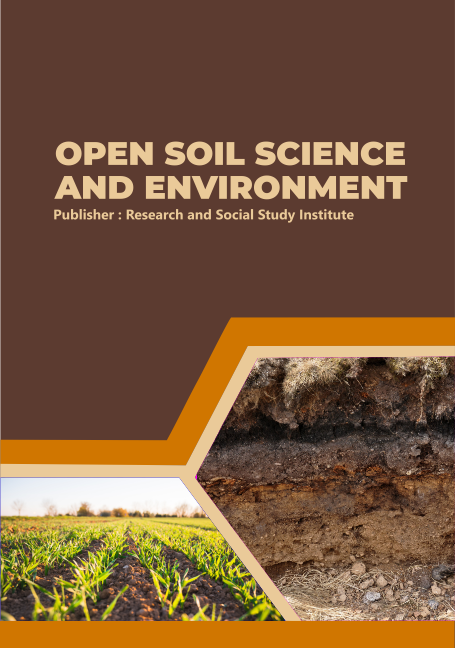Characterization of Mineral Absorption in Freshwater Mussel Gills (Pilsbryoconcha exilis Lea 1883) Using Scanning Electron Microscopy (SEM): Implications for Environmental Remediation
DOI:
https://doi.org/10.70110/osse.v2i2.19Keywords:
Absorption, Characterization, Freshwater mussels, SEMAbstract
Background: Freshwater mussels (Pilsbryoconcha exilis) are known as filter feeders with high survival resilience and can be utilized to address water pollution caused by various pollutants, including heavy metals.
Aims: This study aims to identify and characterize the minerals absorbed in the gills of freshwater mussels using Scanning Electron Microscopy (SEM) techniques.
Result: The research results show that, on average, SEM analysis of the freshwater mussel gills identified five metal elements: Carbon (C), Oxygen (O), Phosphorus (P), Sulfur (S), and Calcium (Ca). Quantitative analysis revealed the following concentrations of these elements: C: 52.70±0.12; O: 31.78±0.20; P: 5.18±0.06; S: 0.65±0.02; Ca: 9.70±0.10.
Conclusion: Based on quantitative analysis, these elements are present in varying proportions, with Carbon being the dominant element. This finding suggests that these metal elements, classified as micronutrients, are necessary for freshwater mussels (kijing), although they can be potentially harmful at certain concentrations. Further research on the potential use of freshwater mussels in environmental remediation is needed, considering their ability to absorb heavy metals. This could be part of a strategy for managing pollution in freshwater systems.
Downloads
References
Adam, M. A., Maftuch, M., Kilawati, Y., & Tahirah, S. N. (2018). Analysis of Heavy Metal Pollutant in Wangi River Pasuruan and Its Impact on Gambusia affinis. Jurnal Pembangunan Dan Alam Lestari, 9(2), 120–128. https://doi.org/10.21776/ub.jpal.2018.009.02.09
Aliza, D., Sutriana, A., Nazaruddin, N., Armansyah, T., Etriwati, E., Hanafiah, M., Hafizuddin, H., Hasan, D. I., Awaluddin, A., & Ulfa, B. (2021). Histopathological Changes in the Gills of Oreochromis mossambicus Exposed to Mercury Chloride (HgCl 2 ) . Proceedings of the 2nd International Conference on Veterinary, Animal, and Environmental Sciences (ICVAES 2020), 12(Icvaes 2020), 74–80. https://doi.org/10.2991/absr.k.210420.017
Bigas, M., Durfort, M., & Poquet, M. (2001). Cytological effects of experimental exposure to Hg on the gill epithelium of the European flat oyster Ostrea edulis: Ultrastructural and quantitative changes related to bioaccumulation. Tissue and Cell, 33(2), 178–188. https://doi.org/10.1054/tice.2000.0169
Firmansyah, Y. W., Setiani, O., & Darundiati, Y. H. (2021). Kondisi Sungai di Indonesia Ditinjau dari Daya Tampung Beban Pencemaran: Studi Literatur. Jurnal Serambi Engineering, 6(2), 1879–1890. https://doi.org/10.32672/jse.v6i2.2889
Gassim, F. A.-Z. G. (2023). Mercury Pollution: Dangers and Treatment. In M. Mancuso, M. H. H. Abbas, T. Bottari, & A. A. Abdelhafez (Eds.), Marine Pollution (p. Ch. 10). IntechOpen. https://doi.org/10.5772/intechopen.108390
George R C, Gregory M A, Marshall D J, Anandraj A, & McClurg T P. (1998). The surface morphology of gill filaments in Perna Perna after exposure to mercury. Microscopy Society of Southern Africa, 28, 87.
Hamidah, A., & Anggereini, E. (2021). The Effect of the Heavy Metal Mercury (Hg) Concentration on the Growth Rate of Pilsbryoconcha spp Mussel. Proceedings of the 3rd Green Development International Conference (GDIC 2020), 205(Gdic 2020), 181–185. https://doi.org/10.2991/aer.k.210825.033
Hutagalung, H., & Syamsu, S. (1987). Heavy Metal Content in Some Seafoods Collected From Muara Angke Fish Auction Place, Jakarta. Marine Research in Indonesia, 26(1), 51. https://doi.org/10.14203/mri.v26i0.407
Komarawidjaja, W. (2006). Kajian Adaptasi Kijing Pilsbryoconcha exilis Sebagai Langkah Awal Pemanfaatannya Dalam Biofiltrasi Pencemar Organik Di Perairan Waduk. J.Tek.Ling, 7(2), 160–165.
Muliari, Akmal, Y., Zulfahmi, I., Juanda, R., Karja, N. W. K., & Nisa, C. (2018). Histopathological changes in gill of Nile tilapia (Oreochromis niloticus) after palm oil mill effluent exposure. IOP Conference Series: Earth and Environmental Science, 216(1). https://doi.org/10.1088/1755-1315/216/1/012003
Nataraj, B., Maharajan, K., Hemalatha, D., Rangasamy, B., Arul, N., & Ramesh, M. (2020). Comparative toxicity of UV-filter Octyl methoxycinnamate and its photoproducts on zebrafish development. Science of the Total Environment, 718, 134546. https://doi.org/10.1016/j.scitotenv.2019.134546
Ningrum, R. A., Adam, M. A., Diniarti, N., Anjani, Y. D., & Maulana, I. (2024). Strategies for Effective Plankton Management in Kijing Taiwanese ( Anodonta woodiana , Lea ): A Study on Stocking Density and Aquaculture Techniques. Indonesian Journal of Limnology, 05(01), 1–10. https://doi.org/10.51264/inajl.v5i1.60
Odey, M. O., Udiba, U. U., Asuk, A. A., & Emuru, E. O. (2020). Heavy metal contamination of african cat fish (Clarias gariepinus) from industrial effluent and domestic waste-contaminated rivers and home bred sources in zaria, nigeria. African Journal of Biomedical Research, 23(1), 101–105.
Parsons, G. R. (2022). Introductory Fish Biology: An Ecophysiological Approach (First). Cambridge Scholars Publishing.
Saksono, N., Bismo, S., Krisanti, E., Manaf, A., & Widaningrum, R. (2010). PENGARUH MEDAN MAGNET TERHADAP PROSES PRESIPITASI CaCO3 DALAM AIR SADAH. MAKARA of Technology Series, 10(2). https://doi.org/10.7454/mst.v10i2.433
Sartika, Adam, M. A., & Aryanti, D. (2024). Identification of Mineral Absorption in the Meat of Freshwater Kijing (Pilsbryoconcha exilis Lea) Using X-Ray Fluorescence (XRF). Applied Research in Science and Technology, 4(01). https://areste.org/index.php/oai
Shita, A. D. P., & Sulistiyani. (2010). Pengaruh Kalsium Terhadap …( Amandia P . S ., Sulistyani ). Stomatognatic (J. K. G Unej), 7(3), 40–44.
Sujatno, A., Salam, R., & Dimyati Pusat Sains dan Teknologi Bahan Maju, A. (2015). Studi Scanning Electron Microscopy (Sem) Untuk Karakterisasi Proses Oxidasi Paduan Zirkonium. Jurnal Forum Nuklir (JFN), 9(2), 44–48.
Szent-Györgyi, A. G. (1975). Calcium regulation of muscle contraction. Biophysical Journal, 15(7), 707–723. https://doi.org/10.1016/S0006-3495(75)85849-8
Utami, R., Rismawati, W., & Sapanli, K. (2018). Pemanfaatan Mangrove untuk Mengurangi Logam Berat di Perairan. Prosiding Seminar Nasional Hari Air Dunia 2018, 2621–7449.
Wedsuwan, T., Musig, W., & Musig, Y. (2016). Water quality control in tilapia closed cultured system using filter feeding fresh water clam (Plisbryoconcha exilis compressa). Kasetsart University Fisheries Research Bulletin, 40(1), 52–65.
Wisha, U. J., Heriati, A., Ramdhan, M., Mustikasari, E., Mutmainah, H., & Ilham, I. (2019). Spatial Distribution of Dissolved Heavy Metals (Hg, Cd, Cu, Pb, Zn) on the Surface Waters of Pare Bay, South Sulawesi. Ilmu Kelautan: Indonesian Journal of Marine Sciences, 23(4), 199–206. https://doi.org/10.14710/ik.ijms.23.4.199-206
Downloads
Published
How to Cite
Issue
Section
License
Copyright (c) 2024 Desta Mamula Audia, Moh. Awaludin Adam, Dwi Ariyanti

This work is licensed under a Creative Commons Attribution-ShareAlike 4.0 International License.










